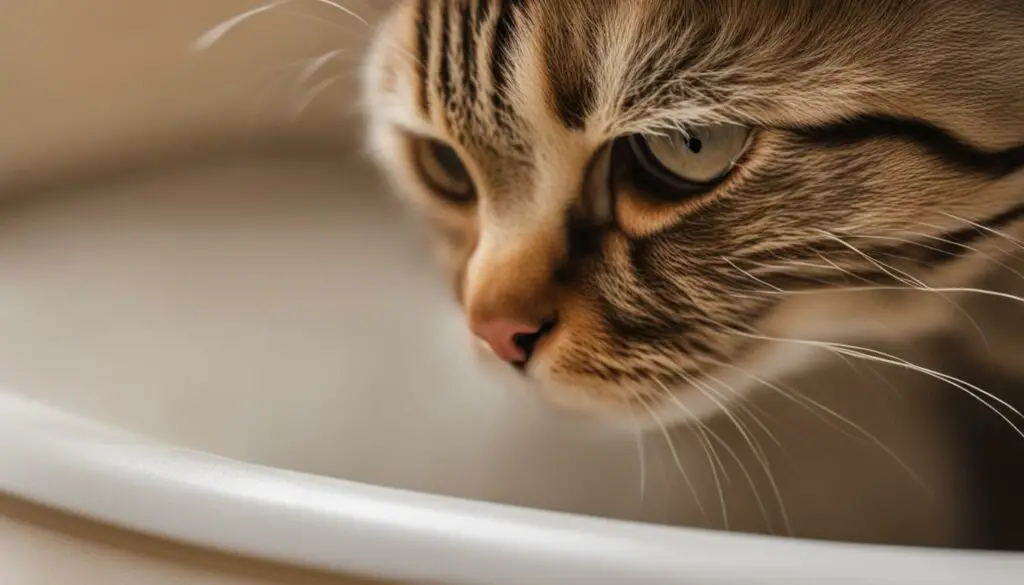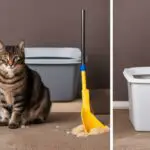Greetings cat owners,
I know firsthand the struggles of dealing with a cat that scratches the sides of their litter box wall. Not only can it be frustrating to clean up the mess, but it can also lead to damage to your furniture. In this article, I will delve into the basics of why cats engage in this behavior, how it can be managed, and what you can do to provide a more harmonious living environment for both you and your feline friend.
Key Takeaways:
- Scratching the sides of the litter box is a natural behavior for cats and can serve various purposes.
- Understanding the reasons behind this behavior can help in managing and redirecting it effectively.
- Providing appropriate scratching materials and environmental enrichment plays a significant role in preventing excessive scratching in the litter box.
- Cat owners should address litter box cleanliness, size, and location to promote proper litter box etiquette.
- If excessive scratching persists or is accompanied by other symptoms, it is important to seek veterinary care.
Why Do Cats Scratch the Sides of the Litter Box?
Cats have a natural instinct to scratch, and one of the places they may choose to do so is the sides of their litter box. There are several reasons behind this behavior. Firstly, cats scratch the sides of the litter box to cover their waste. By using their claws to bury their waste, they are instinctively trying to keep their territory clean and odor-free.
Additionally, scratching the sides of the litter box helps cats clean their paws. Cats are meticulous groomers and use their paws to clean their fur. By scratching the litter box, they are removing any dirt or litter particles that may be stuck to their paws, further maintaining their hygiene.
Another reason why cats scratch the sides of the litter box is to mark their territory. Cats have scent glands in their paws, and scratching leaves behind pheromones that act as a form of communication. By scratching the sides of the litter box, cats are marking it as their territory and sending a message to other cats.
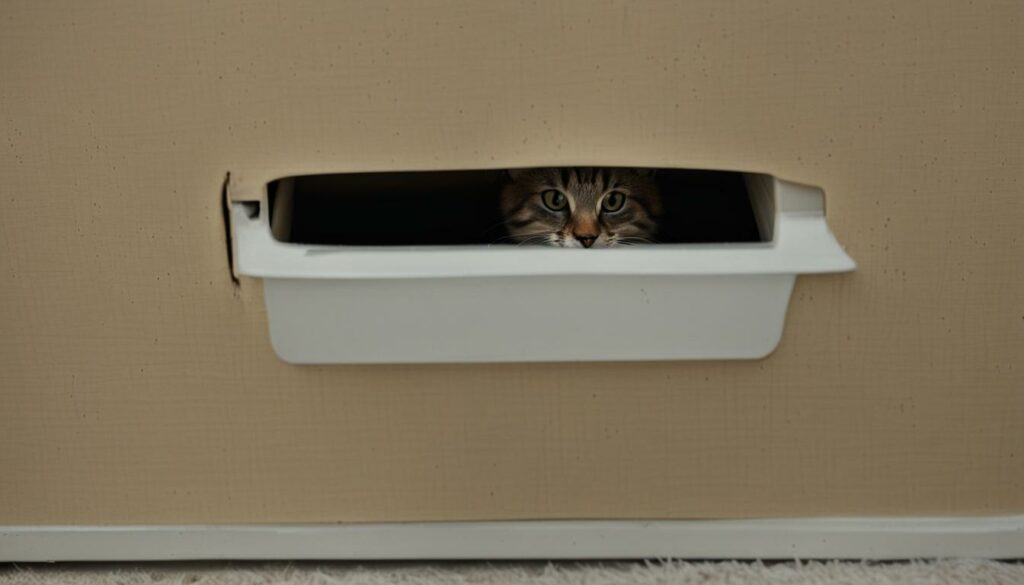
Scratching the Sides of the Litter Box: A Natural Behavior
It’s important to understand that scratching the sides of the litter box is a natural behavior for cats. It serves multiple purposes, from covering waste to maintaining cleanliness and marking territory. To manage this behavior, providing appropriate scratching materials, such as scratching posts or mats, can help redirect their scratching instincts away from the litter box. Remember to choose materials that match your cat’s preferences, whether they prefer vertical or horizontal scratching surfaces.
By addressing the reasons why cats scratch the sides of the litter box and providing suitable alternatives, you can minimize excessive scratching behavior and create a more harmonious environment for both you and your feline companion.
Reasons for Excessive Scratching in the Litter Box
Excessive scratching in the litter box can be frustrating for cat owners, but it is important to understand that there are several reasons why cats may engage in this behavior. By addressing these reasons, you can help alleviate excessive scratching and create a more pleasant litter box experience for your cat.
One common reason for excessive scratching in the litter box is a cat’s preference for certain litter box setups. Cats have individual preferences when it comes to litter box size, shape, and location. Some cats may feel cramped in a small litter box, while others may prefer a covered litter box for added privacy. By experimenting with different litter box options, you can find the setup that your cat feels most comfortable with.
Cat owners should also pay attention to the cleanliness of the litter box. Cats are naturally clean animals and may avoid using a litter box that is dirty or contains odors. Regular scooping and cleaning of the litter box can help prevent excessive scratching and ensure a hygienic environment for your cat.
Another factor to consider is the type of litter used in the litter box. Cats may have preferences for certain textures or scents, and using a litter that your cat dislikes can lead to excessive scratching. Experiment with different types of litter, such as clay, clumping, or natural alternatives, to find the one that your cat prefers.
| Possible reasons for excessive scratching in the litter box: |
|---|
| 1. Inadequate litter box size |
| 2. Dirty litter box |
| 3. Uncomfortable litter box setup |
| 4. Disliked litter type |
| 5. Lack of litter box privacy |
Understanding the reasons behind your cat’s excessive scratching behavior in the litter box is the first step towards finding a solution. By addressing litter box preferences, cleanliness, and providing a suitable litter box setup, you can help your cat feel more comfortable and reduce their urge to scratch excessively.
Litter Box Etiquette
When it comes to litter box etiquette, there are a few key factors to consider in order to promote a clean and comfortable environment for your cat. Here are some important aspects to keep in mind:
1. Private Location
Choosing a private location for the litter box is crucial. Cats prefer to have some privacy while using the litter box, so it’s best to place it in a quiet and secluded area of your home. Avoid placing the litter box in high traffic areas or near loud appliances that may startle your cat.
2. Litter Box Size
The size of the litter box is also important. It should be large enough for your cat to comfortably turn around and dig. If the litter box is too small, your cat may feel cramped and may be more likely to scratch the sides. Consider the size of your cat and choose a litter box accordingly.
3. Litter Preferences
Every cat has their own preferences when it comes to the type of litter they prefer. Some cats prefer clumping litter, while others may prefer non-clumping or natural litter options. Experiment with different types of litter to find out what your cat prefers, and stick to their preference to avoid any discomfort or aversion towards the litter box.
4. Litter Cleanliness
Regularly cleaning and maintaining the litter box is essential for promoting good litter box etiquette. Scoop the litter box at least once a day to remove any waste, and completely change the litter and clean the box on a weekly basis. This will help keep the litter box clean and odor-free, encouraging your cat to use it without excessive scratching on the sides.
Table: Factors to Consider for Litter Box Etiquette
| Aspect | Importance |
|---|---|
| Private Location | Crucial |
| Litter Box Size | Important |
| Litter Preferences | Important |
| Litter Cleanliness | Essential |
By considering these aspects of litter box etiquette, you can help create a pleasant and comfortable space for your cat to do their business, reduce excessive scratching, and strengthen their litter box habits.
Environmental Enrichment and Training
When it comes to managing a cat’s excessive scratching behavior in the litter box, environmental enrichment and training strategies can play a crucial role. By providing cats with alternative scratching options and redirecting their behavior, we can help them satisfy their natural instincts in a more appropriate way.
One effective method of environmental enrichment is to offer various scratching alternatives throughout the house. This can include vertical scratching posts, horizontal scratching pads, or interactive toys that allow cats to engage in their natural scratching behavior. By giving cats a variety of options, we can help meet their individual preferences and reduce the urge to scratch the sides of the litter box.
“Environmental enrichment, such as providing scratching posts and toys, can help redirect a cat’s scratching behavior from the litter box to more appropriate surfaces.”
In addition to providing scratching alternatives, training techniques can be employed to redirect a cat’s behavior away from the litter box. Positive reinforcement is a key aspect of training, rewarding cats when they use designated scratching areas and discouraging them from scratching the litter box walls. This can be done by using treats, praise, or even playtime as a reward for desired scratching behavior.
Using Environmental Enrichment and Training Together
Combining environmental enrichment and training strategies can have a synergistic effect in managing a cat’s scratching behavior. By creating an enriched environment where cats have access to appropriate scratching materials and providing consistent training, we can help them develop positive scratching habits and minimize their desire to scratch the litter box walls.
Remember, each cat is unique and may respond differently to various environmental enrichment and training techniques. It’s essential to observe and understand your cat’s preferences and behavior to determine the most effective strategies for them. With patience, consistency, and an understanding of feline behavior, you can help your cat develop healthy scratching habits and maintain a harmonious living environment.
Choosing the Right Scratching Material
When it comes to satisfying a cat’s scratching needs, providing the right scratching material is essential. Cats have different preferences when it comes to the type of surface they enjoy scratching. Some cats prefer vertical scratching surfaces, while others prefer horizontal ones. By offering a variety of scratching materials, you can cater to your cat’s preferences and reduce their desire to scratch the sides of the litter box.
The choice of scratching material can vary depending on your cat’s individual preferences. Common materials for scratching surfaces include carpet, upholstery, wood, sisal, cardboard, fabric, and leather. Cats may have a preference for certain materials based on their texture, durability, or scent. Observing your cat’s scratching behavior and experimenting with different materials can help you determine which ones they prefer.
Table:
| Scratching Material | Advantages | Disadvantages |
|---|---|---|
| Carpet | Soft texture, mimics natural scratching surfaces | May shed fibers, can be difficult to clean |
| Upholstery | Provides a similar sensation to scratching furniture | May be costly to replace if damaged |
| Wood | Durable and long-lasting | May require regular maintenance to prevent splintering |
| Sisal | Sturdy and provides a satisfying scratching experience | May shed fibers, can be messy |
| Cardboard | Inexpensive and cats enjoy the texture | Not as durable, may need frequent replacement |
| Fabric | Soft and comfortable texture | May collect pet hair, can be difficult to clean |
| Leather | Durable and long-lasting | Can be expensive, may require maintenance |
Experimenting with different scratching materials and observing your cat’s preferences can help you provide the most appealing options. It’s also important to remember that cats may have individual preferences, so offering a variety of scratching materials throughout your home can ensure that your cat always has a suitable option available.
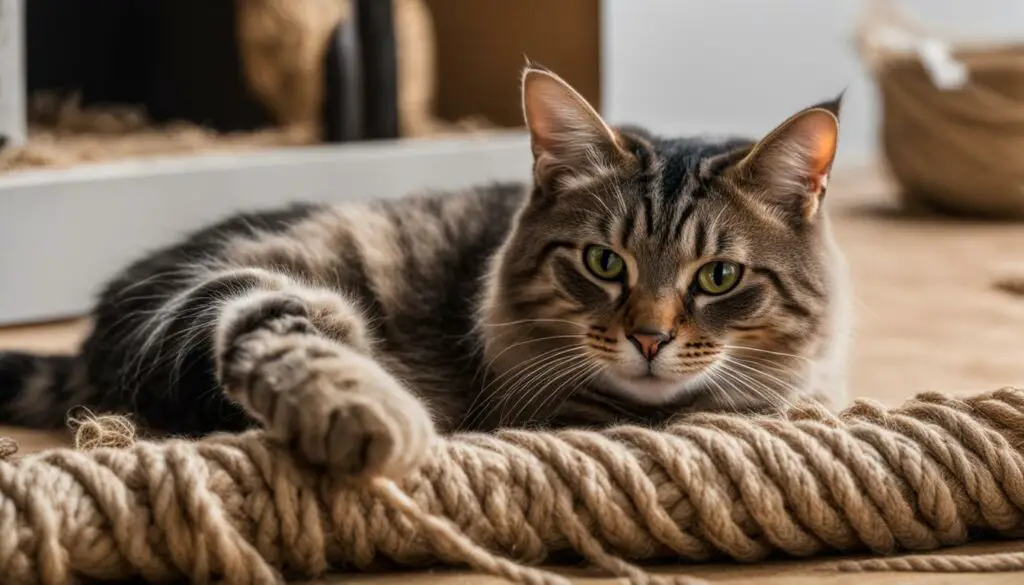
By choosing the right scratching material for your cat and providing a variety of options, you can help redirect their scratching behavior away from the sides of the litter box. Remember to regularly inspect and maintain the scratching materials to ensure they remain in good condition and continue to be attractive to your feline companion.
Managing Territorial Marking Behavior
When it comes to cats, territorial marking behavior, including scratching the sides of the litter box, can be a natural instinct. However, if this behavior becomes excessive, it may be necessary to take steps to manage and modify it. Here are some strategies to help address territorial marking behavior in cats:
- Scent-marking alternatives: Provide your cat with other appropriate outlets for scent marking, such as scratching posts or vertical surfaces. This can help redirect their scratching behavior away from the litter box walls.
- Scratching behavior modification: Train your cat to associate scratching posts or other designated areas with positive reinforcement, such as treats or praise. This can help encourage them to scratch in appropriate places instead of the litter box.
- Consult a feline behaviorist: If your cat’s territorial marking behavior persists or worsens, it may be beneficial to seek the guidance of a feline behaviorist. They can provide personalized advice and techniques to help modify the behavior and create a more harmonious environment.
By addressing territorial marking behavior and providing appropriate alternatives, it is possible to manage and reduce excessive scratching in the litter box. Remember, each cat is unique, and what works for one may not work for another. Be patient and persistent in your efforts to create a more desirable scratching and marking environment for your feline companion.
| Common Strategies for Managing Territorial Marking Behavior | Pros | Cons |
|---|---|---|
| Providing scent-marking alternatives | – Redirects scratching behavior – Helps fulfill instinctual needs – Encourages appropriate marking |
– May take time for cats to adjust – Requires consistent training and reinforcement – Not a guaranteed solution for all cats |
| Scratching behavior modification | – Trains cats to use designated scratching areas – Reinforces positive behavior – Can be effective with consistent training |
– Requires time and patience – May not completely eliminate territorial marking – Some cats may be resistant to training |
| Consulting a feline behaviorist | – Provides expert guidance – Personalized advice for specific cat and situation – Can address underlying issues |
– Requires additional cost – May involve multiple consultations – Results may vary depending on the cat |
“Managing territorial marking behavior in cats requires patience, consistency, and a comprehensive approach. By offering appropriate alternatives, modifying scratching behavior, and seeking professional guidance if needed, cat owners can create a more harmonious environment for their feline companions.” – Feline Behaviorist
Addressing Litter Box Cleanliness
Keeping a clean litter box is crucial to ensure your cat’s comfort and prevent excessive scratching behavior. Cats are naturally clean animals and may avoid using a dirty litter box, leading to frustration and undesirable scratching. To maintain a clean litter box, it’s important to establish a regular cleaning schedule and utilize effective litter box odor control.
Cleaning the litter box should be done at least once a day, scooping out waste and clumps of urine. This not only keeps the litter box clean but also helps prevent unpleasant odors from building up. Additionally, regular cleaning helps maintain the litter’s texture and freshness, making it more appealing to your cat.
Investing in litter box odor control products can also play a significant role in managing cleanliness. Odor control sprays or deodorizers designed specifically for litter boxes can help neutralize odors and create a more pleasant environment for both you and your cat. However, it’s essential to ensure that the products you choose are safe for your cat and do not contain any harmful chemicals.
By establishing a consistent cleaning schedule and utilizing effective litter box odor control, you can create a clean and inviting environment for your cat. This not only promotes proper litter box usage but also helps reduce the likelihood of excessive scratching behavior in the litter box.
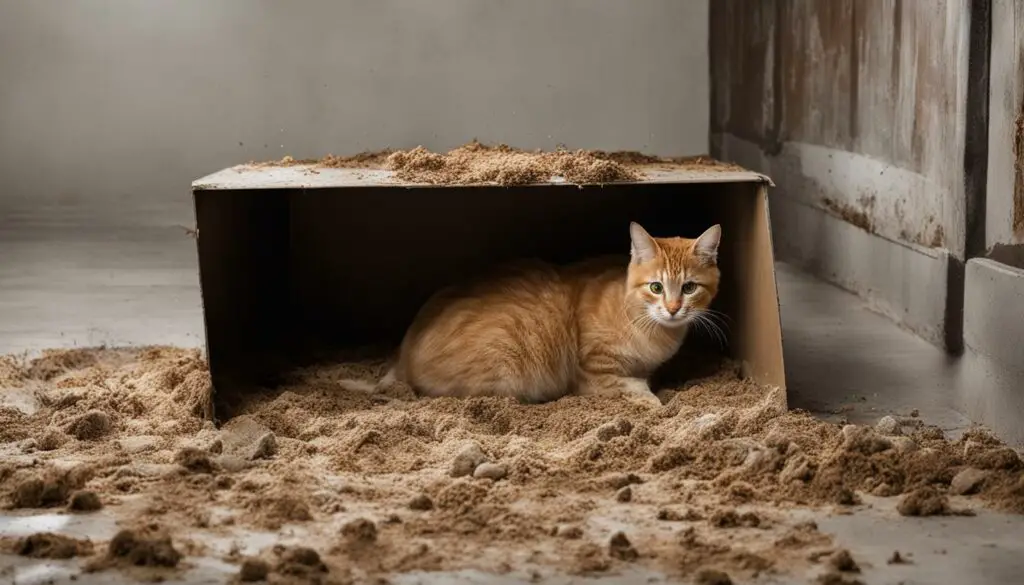
| Litter Box Cleaning Schedule | Litter Box Odor Control |
|---|---|
|
|
Dealing with Multi-Cat Household Conflict
In a multi-cat household, it’s important to address any litter box conflicts that may arise. Providing multiple litter boxes can help prevent such conflicts and reduce excessive scratching behavior. Each cat should have their own designated litter box to ensure they feel comfortable and have their own space.
Having multiple litter boxes helps to avoid competition and territorial disputes among the cats. It allows each cat to have easy access to a clean and private area for eliminating waste. Additionally, providing multiple litter boxes can help maintain cleanliness as the boxes are less likely to become dirty and unappealing to the cats.
When placing the litter boxes, it’s important to consider the layout of the living space and the cats’ preferences. Distribute the litter boxes strategically in different areas of the house, making sure they are easily accessible and provide a sense of privacy. This can help reduce the chances of conflicts and ensure that each cat has a litter box they feel comfortable using.
| Cat | Litter Box Location |
|---|---|
| Whiskers | Kitchen |
| Fluffy | Living Room |
| Oliver | Bedroom |
Regularly cleaning the litter boxes is essential in a multi-cat household. Cats are sensitive to odors, and a dirty litter box can be a source of stress and conflict. Establish a cleaning schedule and make sure to scoop the litter boxes at least once a day. This helps maintain a hygienic environment and ensures that the litter boxes remain appealing to the cats.
By keeping these considerations in mind and providing multiple litter boxes, cat owners can promote harmony among their feline companions and minimize excessive scratching behavior in the litter box.

Potential Health Issues and Scratching Behavior
When dealing with excessive scratching behavior in the litter box, it’s important to consider potential health issues that could be causing or contributing to this behavior. Cats may scratch excessively in the litter box if they are experiencing urinary tract infections or urethral obstructions. These conditions can cause discomfort and pain, leading to increased scratching as a way to relieve their symptoms.
If you notice that your cat’s scratching behavior in the litter box has suddenly become excessive or if it is accompanied by other symptoms such as frequent trips to the litter box, blood in the urine, or difficulty urinating, it is crucial to seek veterinary care promptly. A veterinarian can perform a thorough examination, run tests, and provide the necessary treatment to address any underlying health issues. Treating the medical condition at the root of the excessive scratching behavior is essential for your cat’s well-being.
| Signs of potential health issues: | Seek veterinary care if: |
|---|---|
| • Frequent trips to the litter box | • Scratching behavior is excessive |
| • Blood in the urine | • Cat exhibits other symptoms of discomfort |
| • Difficulty urinating | • There is a sudden change in litter box behavior |
In addition to addressing any potential health issues, it’s essential to provide a consistent and stress-free environment for your cat. Stress can worsen scratching behavior, so implementing stress-relief techniques and providing environmental enrichment can help manage excessive scratching in the litter box. Creating a comfortable and safe space for your cat will promote overall well-being and reduce the likelihood of stress-related behavior problems.

Key Takeaways:
- Excessive scratching in the litter box may be a sign of underlying health issues such as urinary tract infections or urethral obstructions.
- If your cat’s scratching behavior is accompanied by other symptoms or changes in their behavior, it is important to seek veterinary care to rule out any medical conditions.
- Providing a consistent and stress-free environment for your cat, along with implementing stress-relief techniques and environmental enrichment, can help manage excessive scratching in the litter box.
Preventing Excessive Scratching in the Litter Box
Preventing excessive scratching in the litter box is essential for maintaining a clean and harmonious living environment for both cats and their owners. By implementing a few prevention strategies, cat owners can help redirect their cats’ scratching behavior and minimize damage to the litter box walls. Here are some effective techniques:
Proper Litter Box Setup
Ensuring that the litter box is set up correctly can significantly reduce excessive scratching behavior. Choose a litter box that is spacious enough for your cat to comfortably move around in. Place the litter box in a quiet and private location, away from high-traffic areas, to provide a sense of security and privacy for your cat. Also, consider using litter box liners or mats to make cleaning easier and prevent litter from sticking to the walls of the box.
Training Techniques
Training your cat to use appropriate scratching surfaces is crucial in preventing excessive scratching in the litter box. Provide your cat with a variety of scratching posts and surfaces throughout the house, such as sisal, cardboard, or carpeted posts. Encourage your cat to use these designated scratching areas by using positive reinforcement, such as treats or praise, whenever they engage in appropriate scratching behavior. Consistency and patience are key in reinforcing the desired behavior.
Offering Scratching Alternatives
One effective way to prevent excessive scratching in the litter box is by offering your cat alternative scratching surfaces. If you notice that your cat repeatedly scratches the sides of the litter box, place a scratching post or board next to the litter box, so they have an alternative option. Make sure the scratching post or board is appealing to your cat by selecting materials that they enjoy, such as sisal or carpet, and placing it in a location that is easily accessible to them.
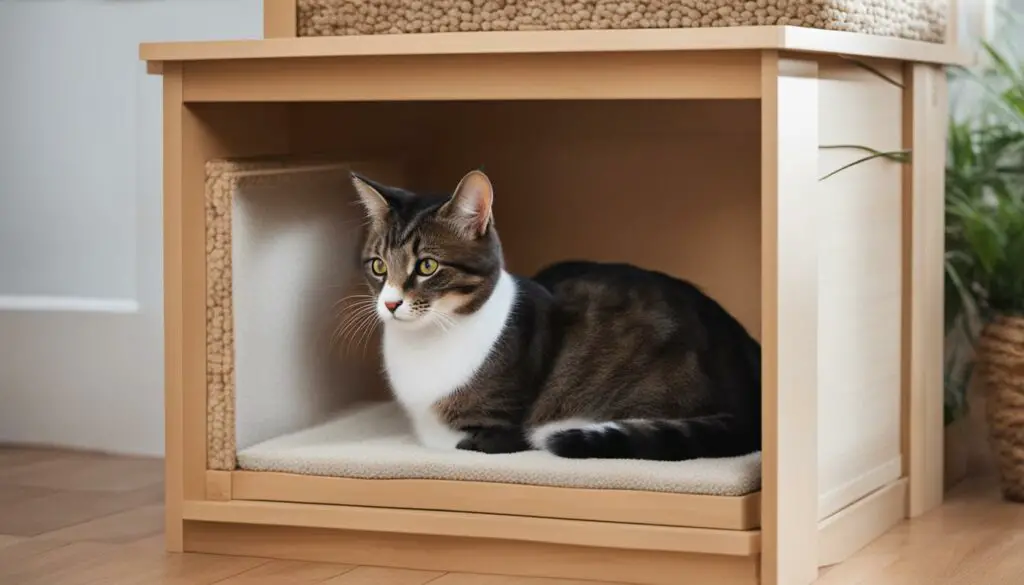
Environmental Enrichment
Providing environmental enrichment for your cat is crucial in preventing excessive scratching behavior. Ensure that your cat has plenty of toys, climbing structures, and interactive playtime to keep them mentally and physically stimulated. A bored cat is more likely to engage in destructive behaviors, such as excessive scratching. By enriching their environment, you can help divert their attention from the litter box walls and encourage them to engage in more appropriate scratching activities.
Remember, preventing excessive scratching in the litter box requires patience and consistency. Implementing these prevention strategies, including proper litter box setup, training techniques, offering scratching alternatives, and providing environmental enrichment, will help redirect your cat’s scratching behavior and create a more harmonious living environment.
Understanding Cat Behavior and Needs
Understanding cat behavior is crucial for cat owners to provide a conducive environment that meets their needs. Cats have a natural instinct to scratch, which serves multiple purposes, such as marking territory, stretching their muscles, and maintaining their claws. By recognizing and addressing these needs, cat owners can prevent excessive scratching in the litter box and promote a harmonious living space.
One essential aspect of understanding cat behavior is recognizing their need for environmental enrichment. Cats require mental and physical stimulation to prevent boredom, stress, and destructive behaviors. Providing scratching posts, toys, and interactive play sessions can help fulfill their need for exercise and engagement. By offering alternative outlets for scratching, such as vertical and horizontal surfaces, cat owners can redirect their pets‘ scratching behavior away from the litter box.
Stress relief is another vital consideration in understanding cat behavior. Cats are sensitive creatures and can become stressed by changes in their environment, conflicts with other pets, or lack of social interaction. A stressed cat may exhibit excessive scratching behavior as a coping mechanism. To address this, cat owners can create a calm and secure environment by providing hiding spots, comfortable resting areas, and ensuring a consistent routine.
In addition to environmental enrichment and stress relief, regular exercise is crucial for a cat’s overall well-being. Engaging in physical activities helps cats alleviate stress, maintain a healthy weight, and prevent boredom. By incorporating play sessions, interactive toys, and even outdoor exploration (if safe and supervised), cat owners can help satisfy their pets‘ need for exercise and reduce their inclination to excessively scratch the litter box.
Understanding cat behavior and needs is key to managing and preventing excessive scratching in the litter box. By providing environmental enrichment, stress relief, and regular exercise, cat owners can create a fulfilling and harmonious environment for their feline companions.
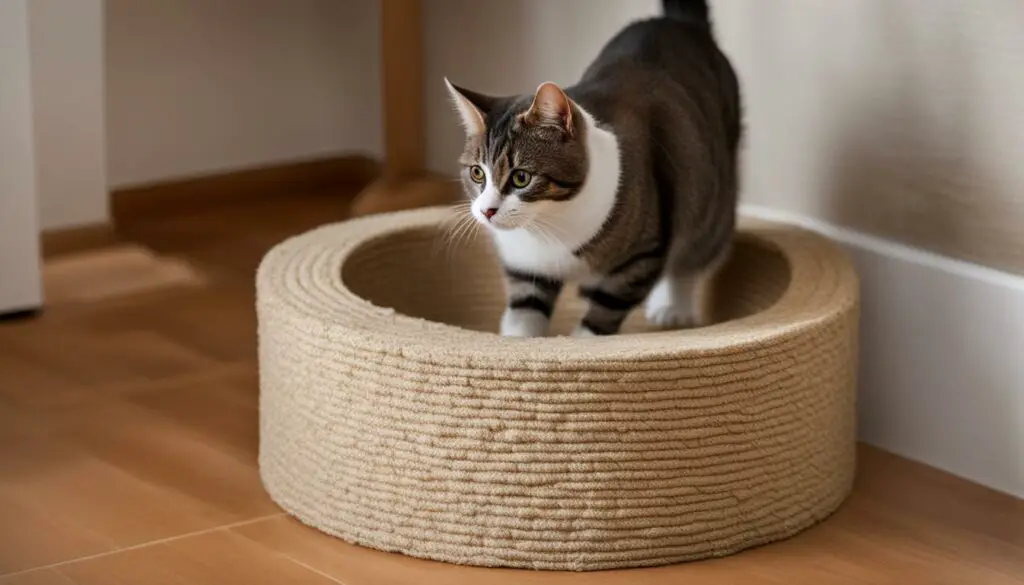
Conclusion
Understanding and managing a cat’s scratching behavior in the litter box is essential for promoting a harmonious environment for both cats and their human companions. Excessive scratching of the litter box wall can be addressed through a combination of solutions and management techniques.
Solutions for Excessive Scratching
Firstly, providing the appropriate litter box setup is crucial. This includes choosing the right size litter box, maintaining cleanliness, and considering the cat’s litter preferences. By meeting these basic requirements, cats are more likely to feel comfortable and satisfied in their litter box.
Secondly, environmental enrichment plays a vital role in diverting a cat’s scratching behavior from the litter box. Offering alternatives such as scratching posts, toys, and a variety of scratching materials can help fulfill their natural instinct to scratch and prevent them from targeting the litter box walls.
Managing Cat’s Scratching Behavior
Training techniques based on positive reinforcement can be employed to encourage desired scratching behavior and discourage excessive scratching in the litter box. Redirecting the cat’s attention to appropriate surfaces and rewarding them for using those surfaces can be effective in shaping their behavior.
In cases where excessive scratching behavior persists or becomes a symptom of territorial marking, seeking guidance from a feline behaviorist can provide valuable insights and strategies for behavior modification.
By understanding the reasons behind a cat’s scratching behavior and addressing their needs through suitable litter box setup, environmental enrichment, and training techniques, cat owners can successfully manage and reduce excessive scratching in the litter box.
FAQ
Why do cats scratch the sides of the litter box?
Cats may scratch the sides of the litter box to cover their waste, keep their paws clean, play, mark their territory, or signal that the litter box is dirty.
What causes excessive scratching in the litter box?
Excessive scratching in the litter box can be caused by factors such as the size of the litter box, the type of litter used, the cleanliness of the litter, or the location of the litter box.
How can I promote proper litter box etiquette?
Promoting proper litter box etiquette involves providing a private location for the litter box, choosing the right size litter box, considering the cat’s litter preferences, and maintaining cleanliness.
How can I redirect my cat’s scratching behavior?
Environmental enrichment, such as providing scratching posts and toys, can help redirect a cat’s scratching behavior from the litter box to more appropriate surfaces. Positive reinforcement training techniques can also be used.
What are the different types of scratching materials for cats?
Cats have different preferences when it comes to scratching materials. Some prefer vertical scratching surfaces, while others prefer horizontal surfaces. Providing a variety of materials such as cardboard, sisal, carpet, or upholstery can help satisfy their scratching needs.
How can I manage territorial marking behavior in cats?
Excessive territorial marking behavior can be managed through behavior modification techniques with the help of a feline behaviorist.
How important is litter box cleanliness?
Cats may avoid using a dirty litter box, so regular cleaning and scooping of the litter box can help maintain a clean environment and prevent excessive scratching.
What should I do in a multi-cat household to prevent litter box conflicts?
Providing multiple litter boxes, each designated for individual cats, can help prevent litter box conflicts and reduce excessive scratching behavior.
Can excessive scratching in the litter box be a sign of health issues?
Yes, excessive scratching behavior in the litter box can be a sign of underlying health issues such as urinary tract infections or urethral obstructions. It is important to seek veterinary care if accompanied by other symptoms or changes in behavior.
How can I prevent excessive scratching in the litter box?
Preventing excessive scratching in the litter box involves providing a suitable litter box setup, implementing training techniques, offering appropriate scratching alternatives, and ensuring environmental enrichment.
How can I understand my cat’s behavior and needs?
Understanding a cat’s natural behavior and needs, such as their scratching instinct, the importance of environmental enrichment, and the role of stress relief and exercise, can help create a conducive environment that reduces excessive scratching behavior in the litter box.

